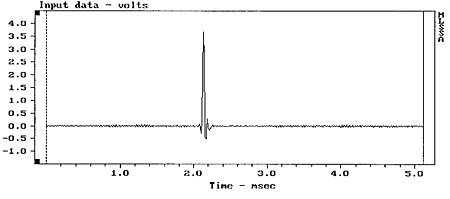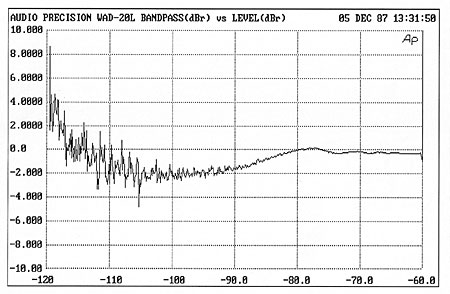| Columns Retired Columns & Blogs |
Wadia Digimaster X-32 digital processor Measurements
Sidebar 3: Measurements
Footnote 1: This puzzles me, as the type of linear-phase impulse response characteristic of conventional "brickwall" low-pass digital filters, which Wadia states in their advertising to feature spurious "intertransient" ringing, is according to the textbooks actually the exact sine x/x impulse response required to accurately reconstruct an analog waveform from a regularly spaced (in time) series of instantaneous voltage samples. (See my "Zen & the Art of D/A Conversion," Stereophile, Vol.9 No.6, September 1986.)—John Atkinson
Fig.1 shows the X-32's frequency response. Like the Wadia 2000, the X-32 features a rapidly rolled-off treble above 10kHz, its response being down more than 3dB at 20kHz. Wadia claims that their DigiMaster decoding software optimizes the performance in the time domain rather than in the frequency domain (footnote 1). Wadia feels that the tradeoff involving depressed top-octave response offered by the DigiMaster/Frenchcurve low-pass filter is more than made up for in the transient response. The exact nature of this digital filter is revealed in the X-32's impulse response, shown in fig.2. It can be seen that there is significantly less ringing before and after the pulse than with conventional filter designs. This lack of ringing can also be seen in the manner in which the X-32 handles a 1kHz squarewave at 0dB (fig.3).

Fig.1 Wadia X-32, frequency response at –12dBFS into 100k ohms with 44.1kHz data (right channel dashed, 0.5dB/vertical div.).

Fig.2 Wadia X-32, impulse response.

Fig.3 Wadia X-32, 1kHz squarewave at 0dBFS.
The X-32's de-emphasis error plot (fig.4) revealed an inconsequential error through the midband, as well as a marginal channel-error difference between channels. Again, the top octave is depressed. Interchannel phase error was perfectly flat, while crosstalk was low and fairly typical of digital decoders, with slightly declining separation as frequency increases (fig.5).

Fig.4 Wadia X-32, De-emphasis response (0.5dB/vertical div.).

Fig.5 Wadia X-32, channel separation (10dB/vertical div.).
The X-32 exhibited unusual behavior on the Chesky Bonger test. In fact, the only other converter that produces a similar sound is the Wadia 2000. During the lowest-level bonger tones, the noise floor can clearly be heard to be modulated by the tone: the noise floor drops at the tone attack and gradually rises as the bonger decays. I've heard this from no other processor except the 2000; not surprising, as they share many fundamental design principles. Usually, the noise floor remains constant and the conversion artifacts become audible in the tone decay.
Fig.6 shows the X-32's fade-to-noise-with-dither performance. The line should appear straight, but actually has some curvature (non-linearity) at levels below –80dB. Computing the deviation from linearity from this plot yields fig.7. Note how the departure from perfect linearity begins at –80dB. This is most likely due to the X-32's staggered DAC array relying on a single MSB trimmer. Looking at the waveform of an undithered –90.31dB 1kHz sinewave (fig.8), it can be seen that the basic stepped waveform is accompanied by rather more high-frequency noise than with the Stax or Theta processors also reviewed this month. (The measurement bandwidth for this signal was 30kHz.) Spectral analysis of a dithered 1kHz, –90.31dB tone on a 1/3-octave basis is shown in fig.9. The linearity error at –90dB is confirmed by the fact that the fundamental's amplitude doesn't quite reach the –90dB horizontal division. A high level of second-harmonic distortion is also visible to the right of the 1kHz tone, confirming the X-32's departure from linearity at these low levels. No other noise or power-line–related problems are evident, however.

Fig.6 Wadia X-32, fade-to-noise with dither, dBR vs time (s).

Fig.7 Wadia X-32, linearity error (16-bit data), dBR vs dBFS.

Fig.8 Wadia X-32, waveform of undithered 1kHz sinewave at –90.31dBFS, CD data.

Fig.9 Wadia X-32, 1/3-octave spectrum with noise and spuriae of dithered 1kHz tone at –90dBFS with 16-bit data (right channel dashed.)
Finally, I looked at the X-32's output spectrum from 200Hz to 30kHz when reproducing a 1:1 mixture of 19kHz and 20kHz tones at a nominal peak level of 0dB. This is a demanding test for a CD player or processor, but some excellent-sounding machines nevertheless produce very low levels of intermodulation spuriae with this signal. The X-32 suffered, due to the limited stop-band rejection featured by its digital filter. While fig.10 shows spuriae levels in the audio band to be satisfyingly low, the story is not so good above 20kHz. The 24.1kHz image of 20kHz (44.1kHz–20kHz) lies just 8dB below the 19kHz level while the 25.1kHz, 19kHz image (44.1kHz–19kHz), which just doesn't appear with other players or processors, is 9.4dB down. In themselves, these images will not have a significant deleterious effect on the sound—and a mix of full-level 19 and 20kHz tones is something that never happens in music. But it has to be said that many preamplifiers and power amplifiers will not be happy when hit with reasonably high levels at these ultrasonic frequencies, and this may well have led to my feeling that the X-32 offered a rather bright sonic signature despite its measured top-octave rolloff.—Robert Harley

Fig.10 Wadia X-32, 19+20kHz at 0dBFS peak into 100k ohms, 16-bit data (right channel dashed; linear frequency scale).
Footnote 1: This puzzles me, as the type of linear-phase impulse response characteristic of conventional "brickwall" low-pass digital filters, which Wadia states in their advertising to feature spurious "intertransient" ringing, is according to the textbooks actually the exact sine x/x impulse response required to accurately reconstruct an analog waveform from a regularly spaced (in time) series of instantaneous voltage samples. (See my "Zen & the Art of D/A Conversion," Stereophile, Vol.9 No.6, September 1986.)—John Atkinson
- Log in or register to post comments




































